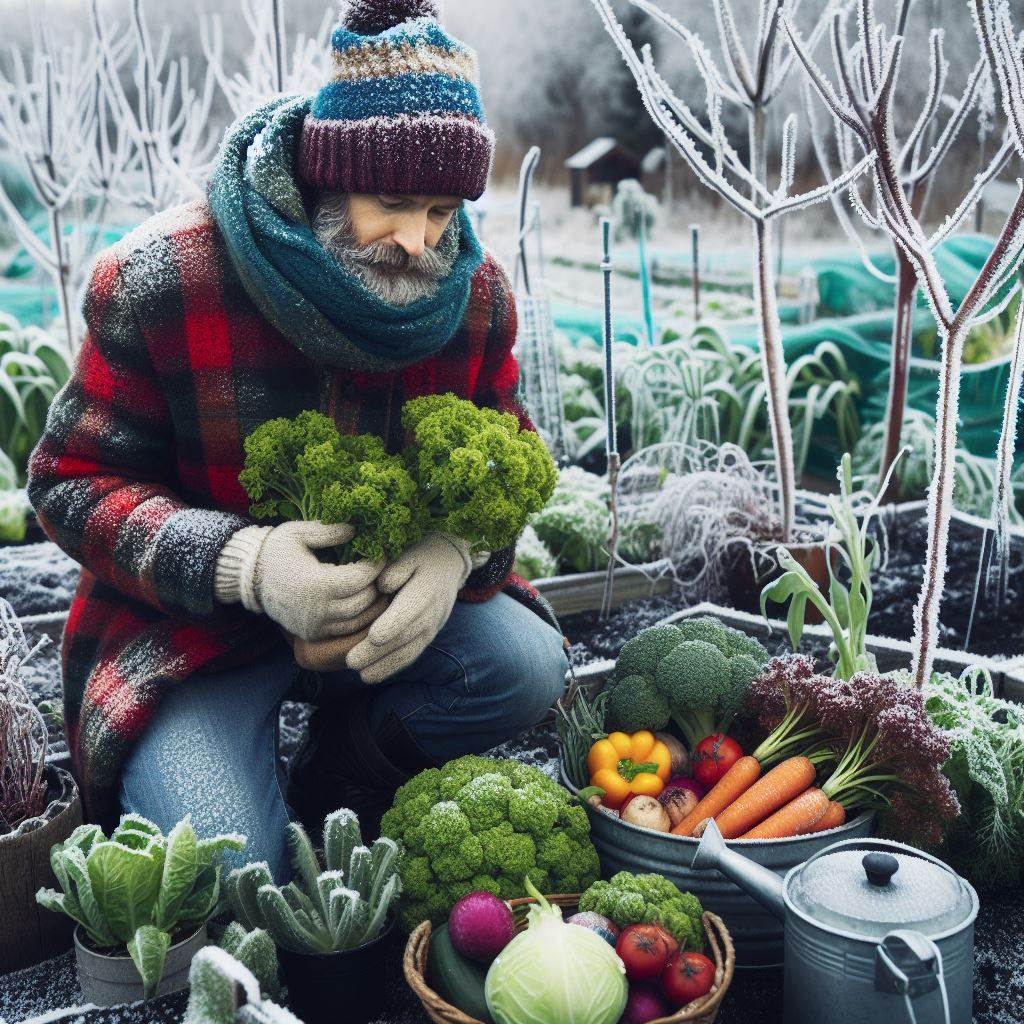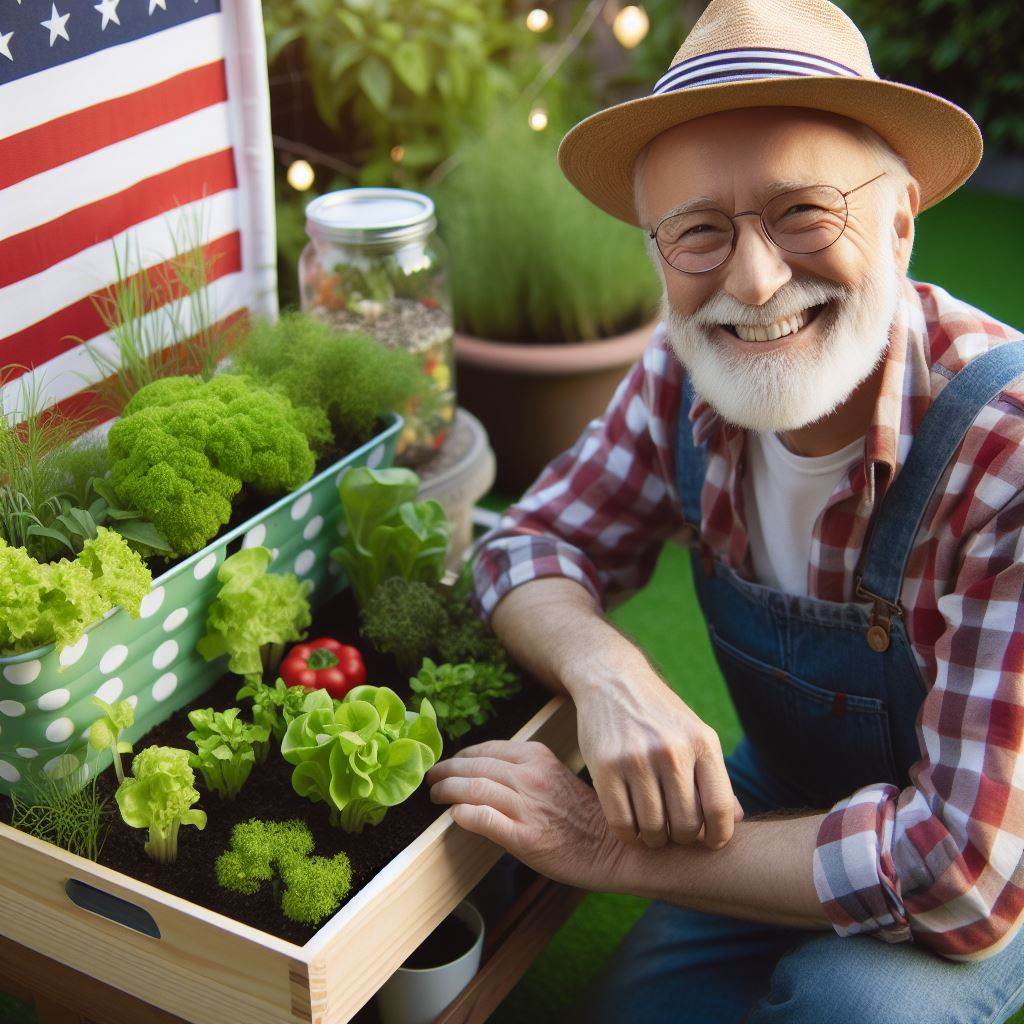Introduction
Discover valuable Winter Organic Gardening Cold Weather Tips to ensure the well-being and sustainability of your garden during the colder months.
Despite the challenges posed by cold weather, there are several tips that can help you continue growing organic produce even in the winter months.
Importance of organic gardening in the winter
Organic gardening in the winter ensures that you have access to fresh and nutritious produce all year round.
It also promotes environmental sustainability by reducing the use of harmful chemicals and pesticides.
Brief overview of the topic
Winter organic gardening involves implementing specific techniques and strategies to protect plants from cold temperatures, frost, and other winter-related challenges.
These methods include using season extenders, selecting cold-hardy varieties, and providing adequate insulation for plants.
By practicing winter organic gardening, you can enjoy a variety of vegetables, herbs, and fruits throughout the winter season.
Not only does this provide you with a more diverse and nutritious diet, but it also saves you money and reduces your carbon footprint.
In the following sections, we will delve deeper into the different aspects of winter organic gardening.
We will explore effective gardening techniques, discuss the selection of suitable crops, and share tips for protecting your garden from the harsh winter conditions.
Stay tuned for valuable insights and practical advice that will help you successfully maintain an organic garden during the winter months.
With the right knowledge and preparation, you can continue enjoying the benefits of fresh, organic produce all year long.
Benefits of Cold-Weather Organic Gardening
Winter organic gardening can offer numerous benefits for gardeners who are willing to brave the cold weather.
By implementing certain strategies and techniques, it is possible to extend the growing season, minimize pest and disease issues, and reduce weed competition.
Here, we will explore the advantages of engaging in cold-weather organic gardening.
Transform Your Agribusiness
Unlock your farm's potential with expert advice tailored to your needs. Get actionable steps that drive real results.
Get StartedLonger growing season
Contrary to popular belief, winter doesn’t mean the end of the gardening season.
By utilizing cold frames, row covers, or hoop houses, gardeners can protect their plants from freezing temperatures and continue growing fresh produce throughout the winter months.
Lower pest and disease pressure
Many pest insects and disease-causing pathogens become less active or dormant during the winter, resulting in reduced pressure on plants.
Cold weather can slow down or even halt the life cycles of these pests and diseases, giving plants a better chance of survival.
Less competition from weeds
Winter is a time when most weeds become less vigorous and grow at a slower pace.
Taking advantage of this natural slowdown, gardeners can focus on cultivating their desired crops without having to constantly battle with weeds.
Mulching and using cover crops can help further suppress weed growth during the winter.
Cold-weather tips to maximize your success
Now that we understand the benefits of cold-weather organic gardening, let’s explore some cold-weather tips to maximize your success:
Choose cold-tolerant crops
When selecting plants for winter gardening, opt for varieties that can withstand colder temperatures.
Examples of cold-tolerant vegetables include kale, spinach, Brussels sprouts, and certain types of lettuce.
Consult your local extension office or seed catalogs for suitable options.
Implement season-extending techniques
As mentioned earlier, cold frames, row covers, and hoop houses are invaluable tools for extending the growing season.
These structures provide additional insulation and protection against frost, allowing plants to thrive in the colder months.
Provide adequate insulation
Mulching is an effective way to insulate the soil and protect plant roots from extreme cold.
Apply a thick layer of organic mulch around the base of plants to maintain soil temperature and minimize freeze-thaw cycles.
Water plants correctly
While it may be tempting to reduce watering during winter, plants still require moisture to survive.
Water them deeply but infrequently, ensuring the soil is well-drained to prevent waterlogging.
Avoid watering during freezing temperatures to prevent damage.
Practice crop rotation
Crop rotation is crucial in organic gardening to prevent the buildup of pests and diseases.
By rotating your crops each season, you disrupt the life cycles of harmful organisms and maintain the health of your soil.
Monitor and manage pests
Although pest activity might be reduced during winter, it is important to remain vigilant.
Regularly inspect plants for any signs of infestations and treat them using organic pest control methods, such as insecticidal soaps or neem oil.
Continuously enrich your soil
Healthy soil is the foundation of a successful organic garden.
During winter, incorporate organic matter like compost, leaf mulch, or cover crops into the soil to improve its fertility and structure for the upcoming growing season.
Showcase Your Farming Business
Publish your professional farming services profile on our blog for a one-time fee of $200 and reach a dedicated audience of farmers and agribusiness owners.
Publish Your ProfileBy embracing winter organic gardening and following these tips, you can enjoy a longer growing season, minimize pest and disease issues, and avoid excessive weed competition.
Don’t let the cold weather deter you from continuing your gardening journey and reaping the rewards of homegrown produce.
Stay motivated, stay informed, and happy gardening!
Read: Organic Garden Pest Identification Guide
Choosing the Right Crops for Winter Gardening
When it comes to winter gardening, selecting the right crops is crucial for a successful harvest.
Here are some cold-weather tips to help you choose the perfect crops for your winter garden:
- Cold-tolerant vegetables: Opt for vegetable varieties that can withstand colder temperatures. Some excellent choices include kale, broccoli, Brussels sprouts, and cauliflower.
- Leafy greens: Leafy greens are perfect for winter gardening as they thrive in cooler temperatures. Consider growing spinach, lettuce, Swiss chard, and arugula.
- Root vegetables: Root vegetables are not only nutritious but also handle cold weather exceptionally well. Carrots, beets, radishes, turnips, and parsnips are all great options for winter gardening.
- Quick-growing crops: To maximize your winter harvest, choose crops that have a shorter maturity period. Look for varieties like radishes, baby carrots, and Asian greens that can be harvested within a few weeks.
When selecting your winter crops, ensure you consider their hardiness zone, which determines the lowest temperatures a plant can tolerate.
Understanding your specific zone can help you choose crops that will thrive in your winter garden.
To determine your hardiness zone, consult the USDA Plant Hardiness Zone Map or your local agricultural extension office.
This information will guide you in making informed decisions about the crops to grow during the winter season.
Once you have decided on the crops, it’s time to prepare your garden for winter.
Tips to ensure the best conditions for your winter crops
Consider the following tips to ensure the best conditions for your winter crops:
- Clear the area: Remove any debris or old plants from the garden bed properly. This will help prevent diseases or pests from overwintering and infesting your new crops.
- Amend the soil: Add compost or organic matter to improve the soil’s fertility and drainage. This will provide the necessary nutrients for the winter crops to thrive.
- Mulch: Apply a layer of organic mulch such as straw or leaves around your plants. Mulching helps regulate soil temperature, retain moisture, and suppress weed growth.
- Protect with row covers: In regions with extremely cold temperatures, consider using row covers or frost blankets to protect your winter crops. These covers provide an extra layer of insulation against freezing temperatures.
- Water wisely: Although winter brings less rainfall, it’s important to water your crops when needed. Water in the morning to allow the plants to dry before nighttime, minimizing the risk of frost damage.
Remember to monitor your winter garden regularly and make adjustments as necessary.
Adjust watering and remove any pests or diseases promptly to ensure the health of your crops.
By choosing the right crops and implementing these cold-weather tips, you can enjoy a bountiful winter harvest and savor the satisfaction of organic winter gardening.
Read: From Water to Table: Hydroponic Growing
Soil Preparation for Winter Gardening
Adding organic matter
- Adding organic matter is crucial for enriching and nourishing the soil during the winter months.
- Organic matter such as compost, leaf litter, and well-rotted manure can be worked into the soil.
- This improves soil structure, enhances drainage, and promotes microbial activity.
- The added organic matter also enriches the soil with nutrients, ensuring healthy plant growth.
Mulching to retain soil warmth
- Mulching is a key practice in winter organic gardening.
- It helps retain soil warmth and protects plants from extreme temperature fluctuations.
- Organic materials like straw, hay, wood chips, or shredded leaves can be used as mulch.
- Apply a layer of mulch around plants, keeping it around 2 to 4 inches thick.
- Mulch acts as an insulating blanket, preventing frost from penetrating the soil and damaging plant roots.
- It also helps to conserve moisture and suppress weed growth, saving time and water.
Protecting soil structure
- Cold weather can have adverse effects on the soil structure, leading to compaction and erosion.
- To prevent this, it is important to protect the soil using cover crops.
- Cover crops like winter rye, clover, or hairy vetch can be sown before winter.
- They help hold the soil together, prevent erosion, and improve water infiltration.
- These cover crops also add organic matter when tilled into the soil in the spring.
Other winter gardening tips
- Provide adequate water to your plants during dry spells, as winter winds can quickly dry out the soil.
- Use row covers or cold frames to extend the growing season and provide extra protection against frost.
- Grouping plants together can create a microclimate, providing better protection against cold temperatures.
- Prune your trees and shrubs during winter to promote healthy growth and shape them for the upcoming seasons.
- Consider using season-extension methods such as high tunnels or greenhouse gardening for more control over temperature and growing conditions.
All in all, soil preparation plays a vital role in successful winter organic gardening.
Adding organic matter, mulching, and protecting soil structure are key practices to ensure optimal plant growth.
By following these tips and incorporating other winter gardening practices, you can enjoy a bountiful and successful organic garden throughout the colder months. Happy gardening!
Read: Urban Oasis: Aquaponic Gardening Basics
Protecting Plants from the Cold
Using row covers and cloches
- Using row covers and cloches can effectively shield your plants from freezing temperatures.
- These covers create a protective barrier that traps heat and creates a microclimate around the plants.
- Cloches are small protective covers placed over individual plants, while row covers are larger and cover entire rows.
- Both options are easy to install and remove, providing flexibility during fluctuating winter weather.
- Row covers and cloches also offer protection against pests and help to retain moisture in the soil.
Building Cold Frames and Hoop Houses
- Cold frames and hoop houses are structures that offer more extensive protection for your plants.
- A cold frame is made of a transparent top, typically glass or plastic, and a solid base.
- It helps to trap heat from sunlight and creates a warm environment for your plants.
- Hoop houses are larger structures made of a series of hoops covered with a greenhouse film.
- These structures provide better insulation and allow for more space to grow a variety of plants.
Providing Adequate Insulation
- Proper insulation is crucial to protect your plants from extreme cold temperatures.
- Applying a thick layer of mulch around the base of your plants helps to retain heat in the soil.
- Mulch acts as an insulating layer, preventing temperature fluctuations that can damage the roots.
- Using materials like straw, leaves, or wood chips as mulch provides optimal insulation.
- Additionally, consider using frost blankets or burlap to protect plants from harsh winds and frost.
Other Essential Tips for Winter Organic Gardening
- Watering your plants properly is essential throughout the winter months.
- Monitor soil moisture levels to ensure plants receive adequate hydration without overwatering them.
- Avoid using freeze-damaged plants as disease and pests are more likely to attack weakened plants.
- Remove any dead or diseased plant material to prevent the spread of pathogens.
- Plan ahead by selecting cold-hardy plant varieties that can withstand the winter conditions.
- Crops like kale, spinach, carrots, and Brussels sprouts are excellent choices for winter gardening.
- Regularly inspect your plants for signs of distress, such as yellowing leaves or wilting.
- Adjust your garden layout to maximize sunlight exposure during the shorter winter days.
- Consider using artificial lighting sources, such as grow lights, to supplement natural sunlight.
- Finally, don’t forget to maintain good garden hygiene by keeping tools and equipment clean and organized.
In short, winter organic gardening requires proactive measures to protect your plants from the cold.
Using row covers, cloches, cold frames, hoop houses, and proper insulation are effective strategies.
By following these tips, you can ensure the health and survival of your plants during the winter season.
Read: Space-Saving Farm: Hydroponic Techniques

Watering and Irrigation
Adjusting watering frequency and amount
- Adjust the frequency and amount of watering to suit the winter conditions in your area.
- Check the moisture levels regularly to ensure the plants are not over or under-watered.
- Avoid waterlogging by improving soil drainage through the addition of organic matter or using raised beds.
- Consider using drip irrigation systems or soaker hoses for more efficient water delivery.
- Install rain barrels to collect and store rainwater, which can be used for watering during dry periods.
Proper drainage and avoiding waterlogging
- Creating proper drainage is crucial for winter organic gardening.
- Ensure that your garden beds are slightly raised to prevent water from pooling.
- Incorporating organic matter into the soil can improve drainage and prevent waterlogging.
- Avoid overwatering, as this can increase the risk of waterlogging and root rot.
- Consider using raised beds or containers, which help with drainage and provide better control over moisture levels.
Conserving water during colder months
- During winter, water conservation becomes even more important.
- Mulch your garden beds to reduce evaporation and maintain moisture levels.
- Use a layer of organic material such as straw, wood chips, or leaves as mulch.
- Group plants with similar water needs together to minimize water wastage.
- Consider using plant varieties that are more drought-tolerant and require less water.
Adjusting watering frequency and amount
- The watering needs of plants change during the colder months.
- Reduce the frequency of watering as plants require less water in winter.
- Instead of shallow, frequent watering, focus on deep watering less frequently.
- Allow the soil to dry slightly between waterings to prevent waterlogged roots.
- Monitor plants closely to determine their specific watering requirements.
Essentially, proper watering and irrigation techniques are essential for successful winter organic gardening.
Adjusting watering frequency and amount, ensuring proper drainage, and conserving water are crucial factors to consider.
Implementing these tips will help your plants thrive even in the cold weather.
Managing Pests and Diseases in Winter
Winter gardening brings its own set of challenges, including managing pests and diseases in the cold weather.
However, with some proactive monitoring and organic pest control methods, you can keep your winter garden thriving.
In this section, we will explore effective strategies for managing pests and diseases during the winter season.
Monitoring for signs of infestation
- Regularly inspect your plants for signs of pests, such as chewed leaves or holes.
- Look for any unusual growth patterns, discoloration, or wilting that may indicate a disease.
Using organic pest control methods
- Employ natural predators like ladybugs and lacewings to control aphids and other small insects.
- Introduce beneficial nematodes to your soil to combat soil-dwelling pests like grubs and larvae.
- Utilize insecticidal soaps or oils, such as neem oil, to target soft-bodied insects while minimizing harm to beneficial insects.
- Apply organic repellents, such as garlic spray or diatomaceous earth, to ward off pests.
Preventing disease spread
- Practice good sanitation by removing dead or infected plant material from your garden regularly.
- Space your plants adequately to promote airflow and reduce moisture buildup, which can contribute to fungal diseases.
- Avoid overwatering your plants as excess moisture can lead to root rot and other fungal infections.
- Rotate your crops each year to prevent the buildup of disease-causing pathogens in the soil.
Implementing organic disease management strategies
- Apply preventative measures such as copper sprays or sulfur-based fungicides to protect susceptible plants.
- Use resistant plant varieties that are less prone to common diseases in your region.
- Opt for disease-resistant rootstocks when grafting fruit trees or perennial crops.
- Mulch around your plants to prevent soil-borne diseases from splashing onto foliage during rain or irrigation.
By following these practices, you can effectively manage pests and diseases in your winter garden while avoiding the use of harsh chemicals.
It’s essential to stay vigilant and address any signs of infestation or disease promptly to prevent further damage.
Prevention is key in organic gardening
Remember, prevention is key in organic gardening, so it’s crucial to maintain a healthy and diverse ecosystem in your garden.
Encourage beneficial insects, birds, and other wildlife to inhabit your garden, as they can help control pests naturally.
Additionally, always keep a close eye on weather forecasts and be prepared to protect your plants during extreme cold snaps or other severe weather conditions.
Use row covers, cold frames, or even DIY protective structures to shield your plants and extend the growing season.
In general, managing pests and diseases in your winter organic garden requires a combination of monitoring, prevention, and intervention.
By utilizing organic pest control methods, practicing good sanitation, and implementing disease management strategies, you can maintain a thriving garden even during the coldest months.
Embrace the challenges of winter gardening and enjoy the rewards of a healthy and sustainable garden.
Gain More Insights: Soil Health: Key for Seasonal Planting
Showcase Your Farming Business
Publish your professional farming services profile on our blog for a one-time fee of $200 and reach a dedicated audience of farmers and agribusiness owners.
Publish Your ProfileHarvesting and Storage Tips for Winter Crops
Knowing the Right Time to Harvest
It is crucial to determine the optimal time for harvesting winter crops.
Monitoring the maturity of vegetables and fruits helps achieve maximum flavor and nutrient content.
Proper Handling and Storage Techniques
After harvesting, handle winter crops gently to prevent bruising or damage.
Remove any excess foliage and dirt, then wash and dry them thoroughly.
Damaged produce should be consumed immediately to avoid spoilage.
Utilizing Freezing and Canning Methods
Freezing is an excellent technique to preserve winter crops.
Blanch vegetables by briefly immersing them in boiling water, followed by an ice water bath.
Freeze in airtight containers or freezer bags.
Canning is another popular method
Using a pressure canner or water bath canner, process winter produce in glass jars.
Follow proper canning guidelines to ensure food safety and prolong shelf life.
Canned goods can be stored for several months.
Proper handling and storage techniques
Harvesting and storing crops during the winter months can be challenging.
However, with the right techniques and knowledge, you can enjoy fresh produce all season long.
Knowing the Right Time to Harvest
Monitor winter crops regularly to determine when they reach their peak ripeness.
Check for color, texture, and size to ensure optimal flavor and quality.
Proper Handling and Storage Techniques
Handle harvested crops with care to prevent damage.
Use clean tools and containers to minimize the risk of contamination.
Store in a cool, dry place to maintain freshness.
Utilizing Freezing and Canning Methods
Freezing is a simple and effective method for preserving winter crops.
Wash and chop vegetables, then blanch them briefly before freezing.
Label each package with the date for easy identification.
Canning is another great option
Follow tested recipes for canning winter crops.
Use the appropriate canning method based on the acidity level of the produce.
Ensure jars are properly sealed before storing.
Make use of root cellars
Root cellars provide an ideal environment for storing winter crops.
These underground storage spaces offer consistent temperature and humidity levels, extending the shelf life of your harvest.
Create a winter pantry
Stock up on preserved winter crops, such as pickles, jams, and dried fruits.
Store them in a designated pantry area for easy access throughout the season.
Rotate stored produce
Regularly check and rotate your stored winter crops to ensure freshness.
Consume items nearing expiration first and replace them with newly harvested ones.
Experiment with fermentation
Fermenting winter vegetables, like cabbage for sauerkraut or beets for kvass, offers a unique way to extend their shelf life while adding flavor and probiotics to your diet.
Share your harvest
If you find yourself with an abundance of winter crops, consider sharing them with friends, family, or your local community.
Spread the joy of fresh, organic produce during the cold season.
Keep learning and adapting
Winter organic gardening requires continuous learning and adaptation.
Experiment with different crops, storage techniques, and preservation methods to find what works best for your specific region and climate.
With these harvesting and storage tips, you can make the most of your winter organic garden and enjoy fresh, nutritious produce all season long.
Embrace the cold weather and nurture your winter crops with care.
Winter Organic Gardening Tips and Tricks
When it comes to winter organic gardening, there are several tips and tricks to keep your garden thriving even in the coldest months.
In this section, we will explore some effective strategies that will help you make the most of your winter garden.
Maximize sunlight exposure
During the winter, sunlight is scarce, so it’s crucial to maximize the little light available.
Showcase Your Farming Business
Publish your professional farming services profile on our blog for a one-time fee of $200 and reach a dedicated audience of farmers and agribusiness owners.
Publish Your ProfilePlace your plants in a location that receives the most sunlight throughout the day.
Consider pruning nearby trees or shrubs that may be blocking the sun’s rays.
Utilize protective windbreaks
Winter winds can be harsh and damaging to plants.
To protect your garden from strong gusts, create windbreaks using fences, hedges, or other structures.
This will help shield your plants and prevent them from drying out.
Rotate crops to maintain soil fertility
Crop rotation is an essential practice in organic gardening.
It helps prevent the buildup of pests and diseases while maintaining soil fertility.
In winter, choose cold-tolerant crops like kale, spinach, and Brussels sprouts, and rotate them with nitrogen-fixing varieties to enhance soil health.
Mulch and insulate your soil
Applying a layer of mulch to your garden beds can provide insulation and protect the soil from extreme temperatures.
Organic materials like straw, leaves, or compost can act as a natural barrier against the cold, helping to retain moisture and prevent soil erosion.
Provide adequate watering
Although plants may not require as much water in winter, it’s crucial to keep them hydrated.
Water your garden beds thoroughly before a deep freeze to ensure the roots are adequately moist.
Be mindful of overwatering, as excessive moisture can lead to root rot.
Build cold frames or row covers
Extend the growing season by constructing cold frames or using row covers.
These structures create a microclimate that shields plants from freezing temperatures.
Cold frames can be built from materials like old windows and provide a protected environment for delicate plants.
Protect plants from frost
Frost can be detrimental to tender plants.
Cover them with blankets, burlap sacks, or specialized frost cloths during cold nights.
Remember to remove the covers during the day to allow sunlight and proper ventilation.
Try companion planting
Companion planting is an effective way to protect plants from pests and diseases.
For example, planting garlic near roses can deter aphids.
Research companion planting combinations that work well in winter and incorporate them into your garden plan.
Use organic pest control methods
Pests can still be a nuisance in winter.
Avoid using chemical pesticides and opt for organic pest control methods.
This may include handpicking pests, introducing beneficial insects, or using homemade pest-repellent sprays made from natural ingredients.
Plan for early spring planting
Use winter as an opportunity to plan for early spring planting.
Start seeds indoors or prepare seedbeds for direct planting as soon as the weather warms up.
This will give you a head start and ensure a bountiful harvest when the growing season begins.
In a nutshell, winter organic gardening requires careful planning and implementation of various strategies to protect and nurture your plants.
By maximizing sunlight exposure, utilizing windbreaks, rotating crops, and following other tips outlined above, you can enjoy a flourishing garden year-round.
Embrace the cold weather and let your green thumb thrive in winter!
Conclusion
Winter organic gardening can be a rewarding and fruitful experience.
By following the cold-weather tips discussed earlier, you can successfully grow a variety of plants even in low temperatures.
Recap of key points
To recap, it is important to choose cold-hardy crop varieties, protect your plants from frost and wind, and provide them with adequate water and sunlight.
Additionally, utilizing season extenders such as row covers and cold frames can significantly enhance your gardening success during the winter months.
Encouragement to try winter organic gardening
We encourage you to give winter organic gardening a try!
It may seem challenging at first, but with the right preparation and care, you can enjoy fresh homegrown produce all year round.
Remember, gardening is a continuous learning process, and each season brings its own rewards and lessons.
Closing thoughts
As you embark on your winter organic gardening journey, embrace the beauty of nature and the satisfaction of growing your own food.
Take a moment to appreciate the resilience and adaptability of plants, and marvel at the wonders of a winter wonderland garden. Happy gardening!
Showcase Your Farming Business
Publish your professional farming services profile on our blog for a one-time fee of $200 and reach a dedicated audience of farmers and agribusiness owners.
Publish Your Profile



